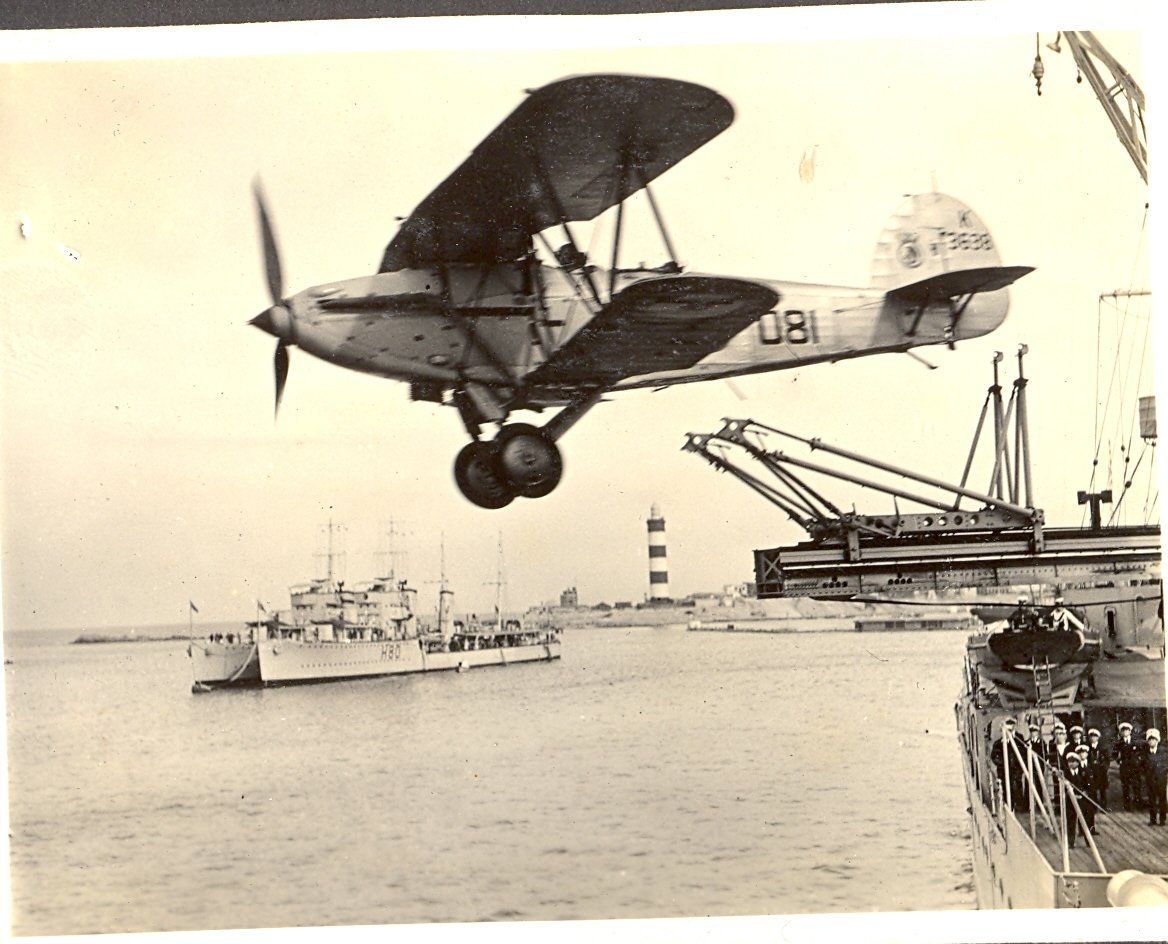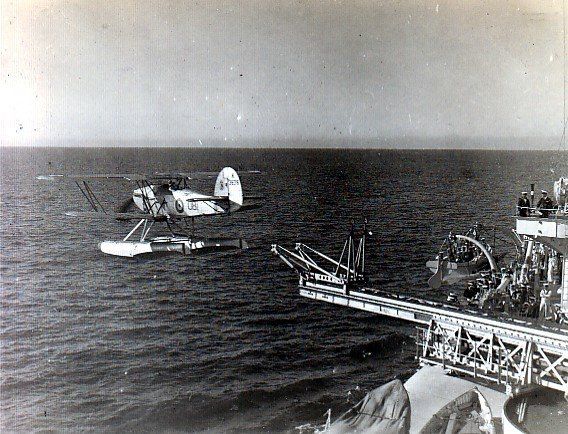Aircraft of Ajax and the Ships at the River Plate
Hawker Osprey (Mk1 – 1V)
General Specification (for Seaplane)
Engine – Rolls-Royce Kestrel V12 cylinder water-cooled engine – 525hp (640hp for later ones)
Length – 31ft 10in (9.74m)
Wingspan – 37ft (11.28m)
Height – 10ft 5in (3.18m)
Weight unladen – 2530lbs (1148kg)
Weight gross – 5570lbs (2526kgs)
Maximum speed – 146mph (234kmh)
Range – 430 miles (690km)
Ceiling – 22800ft (6900m)
De Havilland DH82 Queen Bee
A development of the Tiger Moth, the Queen Bee appeared in 1935 as a pilotless radio-controlled drone, a generic term for a pilotless aircraft. The term Queen Bee and drone are linked – the male honey bee, a drone, flies off to fertilise a Queen Bee. It had a wooden fuselage from the Gipsy Moth and the wings of the Tiger Moth.
It was capable of being piloted for test flights and ferrying but had a radio-controlled system in the rear cockpit to operate the controls pneumatically. The controller operated from a nearby launch ship. It was flown for target practice. If the aircraft survived the practice, as intended, it could be recovered for future use.
For seven weeks in February and March 1936 Ajax worked with HMS Australia in Alexandria as back-up controller of the target drone. The aircraft were kept ashore and when needed HMS Australia would hoist one onto her catapult and put to sea. There it was launched – it is not clear if Ajax flew one but was closely involved in the Fleet anti-aircraft practice. HMS Achilles is also reported to have been involved at some stage.
De Havilland DH82 Queen Bee
General Specification
Engine – de Havilland Gipsy Major 1 – 130hp
Wingspan – 29ft 4in (8.94m)
Weight gross – 1825lbs (828kgs)
Maximum speed – 104mph (167kmh)
Range – 300 miles (483km)
VICKERS SUPERMARINE WALRUS
The Supermarine Walrus was developed from the 1920s Seagull in response to official requests for an amphibian aircraft capable of being catapult launched from cruisers. Following further developments and trials, on 16 March 1936 the Fleet Air Arm took delivery of the Walrus. Production ceased in January 1944 no doubt hastened by the introduction of radar that meant spotter planes were superseded.
Apparently the Walrus was affectionately known as the “shagbat” or “steam pigeon”.
Exeter first commissioned 27 July 1931. By the time of the Battle of the River Plate in December 1939 her Fairey 111Fs had been replaced by two Walruses, probably fitted during her refit of 1936 as that was the start of the 2nd commission on 29 December 1936, sailing two days later. The Walrus entered service earlier that same year, 16 March 1936. They were flown from her previously fitted pair of fixed catapults angled out from amidships in a ‘V’ shape with the crane on the starboard side. The aircraft were probably the Walrus 1 as the Walrus 11 did not fly until 1940. Exeter’s aircraft were probably powered by the Pegasus 11 M2 as the Pegasus VI engines did not enter service until 1937, after she had sailed.
At the time of the River Plate neither of Exeter’s aircraft were flown since the aircraft and the ship’s crew were not fully worked up to perform pick-ups in open sea where there is a greater risk of damage to the aircraft. In addition, it was planned to use these aircraft to scout the coast of Brazil to seek out possible bases where German U-boats may be planning to hide and so presumably, with this in mind, no additional risks were being taken. Early on both aircraft were damaged by splinters and jettisoned*.
Exeter aircraft Identifier. 780 K8341 & 769 K8343.
*Distinguished Service Medal HMS Exeter awarded to Eric A. Shoesmith, Acting Leading Airman, F.A.A.; "who on his own initiative, despite his clothing being soaked in petrol, climbed on to the top of the centre section of the aircraft and cleared the triatic stay which had fallen across it, thus freeing: the aircraft for jettisoning. While he did this the ship was under heavy fire, the petrol leaking from the aircraft was a great danger, and a Turret was firing on a forward bearing."
Achilles is reported as being the first ship to carry a Supermarine Walrus. Following her refit and recommissioning into the New Zealand Division on 31 March 1936, she sailed from Sheerness on 22 April 1936, calling at Spithead (Portsmouth) to embark the Walrus aircraft (whether one or two is unknown). One believed to have identifier Z1 5774. She left on 26 April to spend nine weeks in the Mediterranean on her way to New Zealand. She was returning to the UK December 1938 to change the on-loan RN personnel and undergo a short refit when it seems she sustained damage due to a severe storm that also damaged the Walrus. Following this short refit she recommissioned and sailed for New Zealand 21 February 1939 arriving Auckland 8 May 1939. (other sources say she refitted 14 July 1938 to March 1939!)
(NZ Museum site http://navymuseum.co.nz/hmshmnzs-achilles-leander-class-cruiser-2/ said
“She departed Auckland early December 1938; proceeding via Panama, A severe storm was encountered in the Atlantic which caused some damage to the ship and the Walrus. Achilles arrived Portsmouth 24 January 1939, recommissioning on 27 January and sailed again for New Zealand on 21 February, reaching Auckland 8 May 1939 having travelled via Suez and Singapore”)
One source says both Walruses were lost before the war. She left New Zealand for South America August 1939 with RAF personnel still on board suggesting the ship still carried a Walrus – it is reported the Walrus was lost on recovery pointing to the possibility it was lost en route to South America.
What is certain is that by the time of the Battle of the River Plate December 1939 she had NO aircraft.
Cumberland is reported to have had three Walrus and whilst highly likely no photographic or documentary evidence has been found as yet to confirm. She was away in the Falklands at the time of the Battle of the River Plate arriving 2 days later.
Ajax was fitted with at least one Walrus at her 1940 refit although there is little or no photographic or documentary evidence of its use has been found as yet to confirm. Ajax’s catapult was removed March 1941, reinstated February 1942 and finally the catapult and aircraft removed at her refit May to October 1942
HEINKEL He-60
Graf Spee was originally fitted with two Heinkel He-60s. The first prototype flew early in 1933 and proved to be underpowered; the second prototype had a more powerful version of the BMW engine but was unreliable with only a slight improvement in its performance. The operational aircraft reverted to the original engine. Its design specification for open sea use meant it was sturdy but heavy and consequently underpowered. They were replaced with the Arados before Graf Spee sailed for the south Atlantic in August 1939.
Heinkel He-60s
General Specification
Engine – BMW V1 6.0 V12 cylinder liquid cooled piston engine - 660hp
Length – 37ft 9in (11.50m)
Wingspan – 44ft 3in (13.5m)
Height – 17ft 5in (5.30m)
Weight unladen – 6030lbs (2735kg)
Weight gross – 7511lbs (3407kgs)
Maximum speed – 150mph (240kmh)
Range – 513 miles (826km)
Ceiling – 16000ft (5000m)
ARADO AR-196A-1
For Graf Spee’s South Atlantic deployment she was fitted with two of the latest Arado Ar-196A-1, the first two off the production line and delivered just in time for her sailing in August 1939.
In Nazi Germany the Luftwaffe were responsible for all air matters and the Bordfliegerstaffel 1/196 Number 1 flight of Number 196 operated the two Graf Spee Arados; however, once at sea they came under the operational command of the Kaptäin zur See. The two aircrew were Luftwaffe personnel; Oberleutnant Detlef Spiering, commander and observer, and Fliegerunteroffizier Heinrich Bongarets(z) the pilot (he was killed during the Battle).
Although two planes were aboard, only one was ever flown, with the other serving as spares. Indeed, a design flaw meant during rough sea landings water sprayed onto the hot engine block causing it to crack This resulted in many repairs and engine replacement from the spare.
On the day before the Battle, returning from a routine reconnaissance flight, the engine was severely damaged necessitating its removal for major repairs. It was, therefore, not available on the 13 December 1939; had it been and flown off for its usual routine early morning flight it may well have spotted the British fleet allowing the Graf Spee the chance to avoid contact.
Arado Ar-196A-1
General Specification
Engine – BMW 132K 9 cylinder air-cooled radial piston engine - 947hp
Length – 36ft 1in (11m)
Wingspan – 40ft 8in (12.4m)
Height – 14ft 7in (4.45m)
Weight unladen – 6592lbs (2990kg)
Gross weight – 8201lbs (3720kg)
Maximum speed – 193mph (311kmh)
Range – 670 miles (1080km)
Ceiling – 23000ft (7010m)












